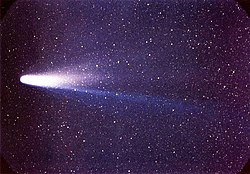Template:Infobox Comet
This template is intended for use on articles about comets.
Usage
{{Infobox comet
| name =
| image =
| caption =
| discovery_ref =
| discoverer =
| discoverery_site =
| discovery_date =
| mpc_name = <!--(Minor Planet Center's designation)-->
| designations = <!--(Alternative names and old-style designations)-->
| orbit_ref =
| epoch =
| observation_arc =
| earliest_precovery_date =
| obs =
| orbit =
| aphelion =
| perihelion =
| semimajor =
| semiminor =
| orbital_circ =
| eccentricity =
| period =
| avg_speed =
| max_speed =
| min_speed =
| inclination =
| asc_node =
| arg_peri =
| long_peri =
| tjup =
| Earth_moid =
| Jupiter_moid =
| physical_ref =
| dimensions = <!--(Uni/bi/tri-axial dimensions)-->
| mean_diameter = <!--(For large, spheroidal minor planets)-->
| mean_radius = <!--(For planets & large, spheroidal minor planets)-->
| equatorial_radius =
| polar_radius =
| flattening =
| circumference =
| surface_area =
| volume =
| mass =
| density =
| surface_grav = <!--(Equatorial surface gravity)-->
| moment_of_inertia_factor = <!--(Moment of inertia factor)-->
| escape_velocity =
| sidereal_day =
| rot_velocity = <!--(Rotational velocity)-->
| rotation = <!--(Rotation period)-->
| axial_tilt =
| right_asc_north_pole = <!--(North pole right ascension)-->
| declination = <!--(North pole declination)-->
| pole_ecliptic_lat = <!--(Pole ecliptic latitude)-->
| pole_ecliptic_lon = <!--(Pole ecliptic longitude)-->
| albedo =
| spectral_type = <!--asteroid spectral class, color indices, etc.-->
| M1 =
| M2 =
| magnitude = <!--apparent magnitude-->
| last_p =
| next_p =
| b_semimajor = <!--barycentric semimajor axis, generally used only for long-period or hyperbolic comets -->
| b_period =
}}
|
Example
 A color image of Comet Halley, shown flying to the left aligned flat against the sky | |
| Discovery | |
|---|---|
| Discovered by | Prehistoric; named after Edmond Halley |
| Discovery date | 1758 (first predicted perihelion) |
| Designations | |
| Halley's Comet, Comet Halley | |
| Orbital characteristics | |
| Epoch | 2449400.5 (17 February 1994) |
| Number of observations | 7,428 |
| Aphelion | 35.0823 AU |
| Perihelion | 0.585978 AU |
| Semi-major axis | 17.8341 AU |
| Eccentricity | 0.967143 |
| Orbital period | 75.32 a |
| Inclination | 162.263° |
| Longitude of perihelion | 169.752° |
| Last perihelion | 9 February 1986 |
| Next perihelion | 28 July 2061 |
| TJupiter | −0.605 |
| Earth MOID | 0.064 AU |
| Physical characteristics | |
| Dimensions | 11 km |
| 0.04 | |
| Comet total magnitude (M1) | 5.5 |
| Comet nuclear magnitude (M2) | 13.6 |
{{Infobox comet
| name = 1P/Halley
| image = [[File:Lspn comet halley.jpg|250px]]
| caption = A color image of Comet Halley, shown flying to the left aligned flat against the sky
| discoverer = Prehistoric; named after [[Edmond Halley]]
| discovery_date = 1758 (first ''predicted'' perihelion)
| designations = Halley's Comet, Comet Halley
| epoch = 2449400.5 <br /> (17 February 1994)
| obs_arc = 158.39 years
| obs = 7,428
| aphelion = 35.0823 [[Astronomical unit|AU]]
| perihelion = 0.585978 AU
| semimajor = 17.8341 AU
| semiminor =
| orbital_circ =
| eccentricity = 0.967143
| period = 75.32 [[Julian year (astronomy)|a]]
| avg_speed =
| max_speed =
| min_speed =
| inclination = 162.263°
| node = 58.420°
| peri = 111.332°
| long_peri = 169.752°
| tjup = −0.605
| Earth_moid = 0.064 AU
| dimensions = 11 km
| M1 = 5.5
| M2 = 13.6
| last_p = 9 February 1986
| next_p = 28 July 2061
}}